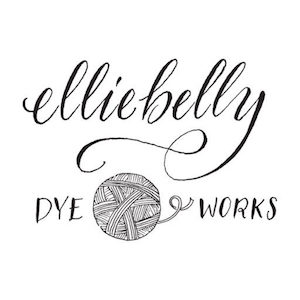Happy Friday! I don't know about you, but it has been a long week for me! I've been away from home and sick at the same time, which is never fun! I can't remember the last time I felt too sick to knit, but that was me. Coming home to my family seems to have been a wonder drug and I'm feeling much better.
Since I don't have knitting of my own to show you this week, I thought I would share a project I've been undertaking with a cohort of amazing knitters. The old Elliebelly website had a page called "What Can I Knit With It" that helped you match patterns with yarns. When I moved my website hosting, there were a couple of glitches, and all of that data was lost. It was time to freshen up those recommendations in any event, so I spent several weeks dyeing yarn in some of my favorite bases, and for the last few months, a group of talented knitters have been knitting with it. Their projects are amazing!
We are on track to have a photo shoot with them at the end of this month, so I can have a new and improved page that helps you match your yarn with projects. Until then, you can take a look at all of the projects on Ravelry by clicking here. Judi's Waiting with Rain, the photo above, is knit with Elliebelly's BFL Sock and illustrates one of those elusive principles of yarn selection.
You can typically make a good substitution of a yarn in your stash for a pattern yarn by focusing on the weight of the yarn, in other words, substituting a dk pattern yarn for a dk yarn in your stash. But this isn't the exclusive consideration. You also need to think about drape. 100% wool yarns are "sprongy." They hold their shape. They are more likely to cling — in a nice way. Yarns with silk, bamboo, cotton, linen, etc., may be more drapey if the content of the not-wool fiber is high enough. Think a drapey shawl. A summer tank top knit out of linen will be loose and drapey but the same pattern, at the same weight, knit in wool, will have a different, more fitted, shape. Of course, it's not an exact science and sometimes, you just have to knit with a yarn to see what it does. The 100% Blue Faced Leicester (sheep's wool) content of Elliebelly BFL sock turns out to be really perfect for shawls. It blocks out to show off the lace patterning perfectly. And, it's warm enough for a little comfort on a cool day without being too heavy. The new "What Can I Knit With It" page, when it's ready, will help knitters make these kinds of selections.
As long as we're on this topic, I'll note that one final factor to consider when substituting yarns is that not all yarns categorized as fingering (or sport, or dk, or worsted, or aran, or bulky) will be the same. Example: a quick perusal of Ravelry shows commercially produced dk weight yarns can run anywhere from 214 to 260 yards for a 100 gram skein. It's important to be aware of differences like this when substituting a yarn for the one recommended in the pattern.
Of course, once you understand these concepts, your ability to substitute yarns in endless. You may deliberately choose to knit a wool cardigan in linen for a looser summer look. A good example is Ishbel, pictured above. If you click on the link to the pattern, you'll see it was written for a 100% wool fingering yarn, although the pattern page also shows a 50 wool/50 Silk blend as an option. The wool version has a lovely drawn in look that emphasizes the lace. The Ishbel shown above is knit in Elliebelly Panda, a 50% silk, 50% Bamboo blend. You might not have thought it would be a good fit for this pattern based on the yarns the designer used, but knowing that her beautiful, complex lace would be shown off to perfection by a drapey, non-wool blend, I chose Panda for this project. Understanding the way the yarn base will work is a key to making a yarn substitution that is quite different from the recommended yarn, but still a success.
Thinking about the results a yarn will give you with the pattern you select is a key to ending up with finished projects you will love and wear over an over again. And as with the time spent on swatching, it's well worth engaging in this exercise before you invest your precious knitting time in a project. I hope that when the new "What Can I Knit With It" page is ready, it will be a really helpful resource for everyone.
